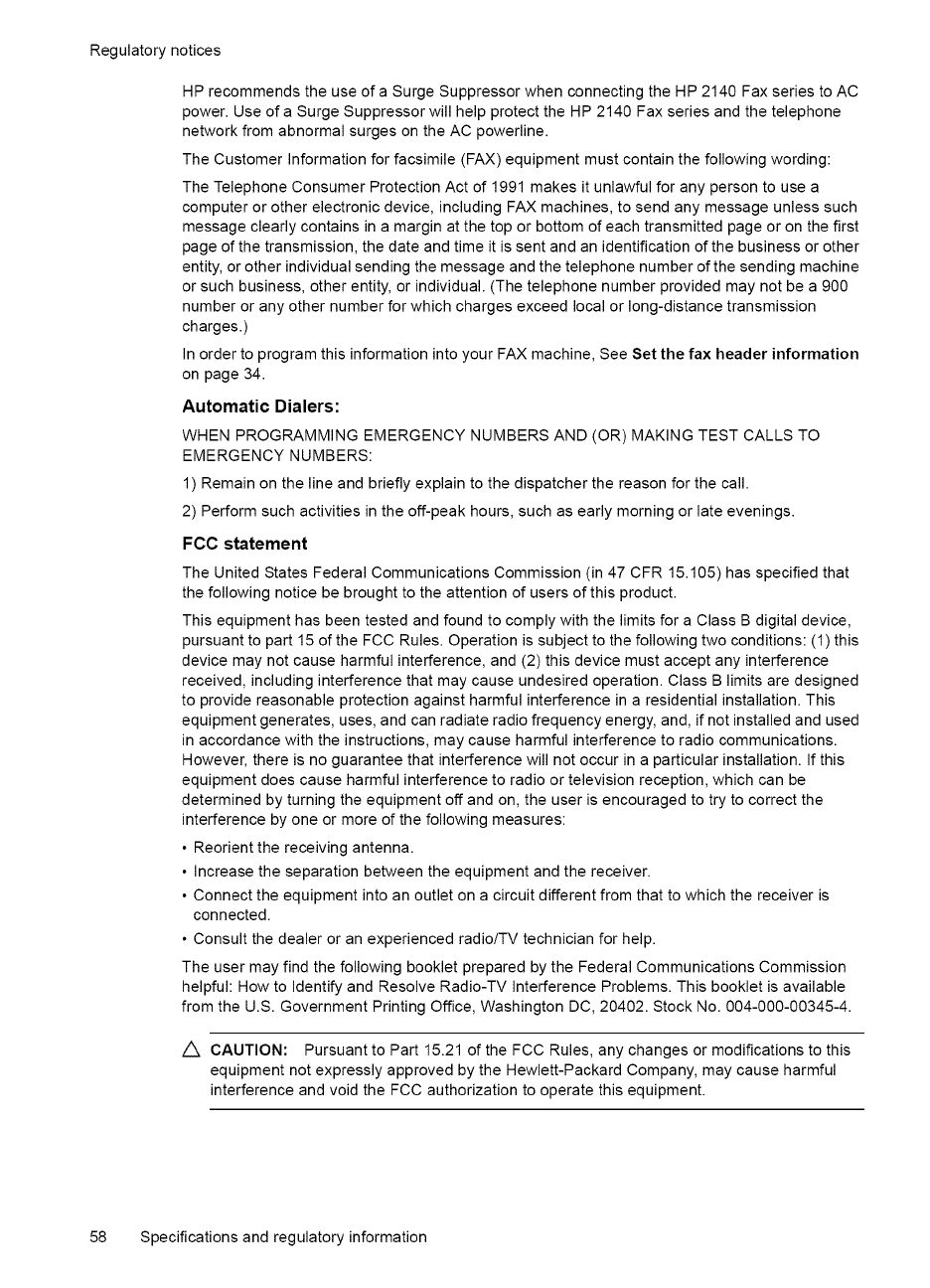
Regulatorynotices
HPrecommendstheuseofaSurgeSuppressorwhenconnectingtheHP2140FaxseriestoAC
power.UseofaSurgeSuppressorwillhelpprotecttheHP2140Faxseriesandthetelephone
networkfromabnormalsurgesontheACpowerline.
TheCustomerInformationforfacsimile(FAX)equipmentmustcontainthefollowingwording:
TheTelephoneConsumerProtectionActof1991makesitunlawfulforanypersontousea
computerorotherelectronicdevice,includingFAXmachines,tosendanymessageunlesssuch
messageclearlycontainsinamarginatthetoporbottomofeachtransmittedpageoronthefirst
pageofthetransmission,thedateandtimeitissentandanidentificationofthebusinessorother
entity,orotherindividualsendingthemessageandthetelephonenumberofthesendingmachine
orsuchbusiness,otherentity,orindividual.(Thetelephonenumberprovidedmaynotbea900
numberoranyothernumberforwhichchargesexceedlocalorlong-distancetransmission
charges.)
InordertoprogramthisinformationintoyourFAXmachine,SeeSetthefaxheaderinformation
onpage34.
Automatic Dialers:
WHEN PROGRAMMING EMERGENCY NUMBERSAND(OR) MAKING TESTCALLSTO
EMERGENCY NUMBERS:
1) Remain on the line and briefly explain to the dispatcher the reason for the call.
2) Perform such activities in the off-peak hours, such as early morning or late evenings.
FCC statement
The United States Federal Communications Commission (in 47 CFR 15.105) has specified that
the following notice be brought to the attention of users of this product.
This equipment has been tested and found to comply with the limits for a Class B digital device,
pursuant to part 15 of the FCC Rules. Operation is subject to the following two conditions: (1) this
device may not cause harmful interference, and (2) this device must accept any interference
received, including interference that may cause undesired operation. Class B limits are designed
to provide reasonable protection against harmful interference in a residential installation. This
equipment generates, uses, and can radiate radio frequency energy, and, if not installed and used
in accordance with the instructions, may cause harmful interference to radio communications.
However, there is no guarantee that interference will not occur in a particular installation. If this
equipment does cause harmful interference to radio or television reception, which can be
determined by turning the equipment off and on, the user is encouraged to try to correct the
interference by one or more of the following measures:
• Reorient the receiving antenna.
• Increase the separation between the equipment and the receiver.
• Connect the equipment into an outlet on a circuit different from that to which the receiver is
connected.
• Consult the dealer or an experienced radio/TV technician for help.
The user may find the following booklet prepared by the Federal Communications Commission
helpful: How to Identify and Resolve Radio-TV Interference Problems. This booklet is available
from the U.S. Government Printing Office, Washington DC, 20402. Stock No. 004-000-00345-4.
/X CAUTION: Pursuant to Part 15.21 of the FCC Rules, any changes or modifications to this
equipment not expressly approved by the Hewlett-Packard Company, may cause harmful
interference and void the FCC authorization to operate this equipment.
58 Specifications and regulatory information


















